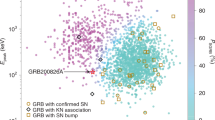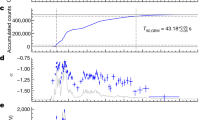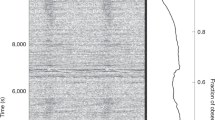Abstract
The combination of high X-ray luminosity1 (∼1038 erg s−1), short orbital period2 (4.8 hours), large non-thermal radio outbursts3–5 and reports of very-high-energy (up to 1015 eV) γ-ray emission6,7 (see also ref. 8) and muon-rich showers9–11 makes Cyg X-3 a unique object among X-ray binaries. Very-high-resolution spatial mapping shows that the radio source starts expanding at the beginning of outbursts and becomes elongated4,5,12, indicating that Cyg X-3 contains a relativistic jet, similar to SS433 (ref. 13). We report here the discovery of a weak (∼4.5 mJy), arcsecond-scale double radio source located symmetrically with respect to the compact variable radio core of Cyg X-3. The double radio source has a separation of about 6 arcsec and is roughly aligned with the elongation direction of the sub-arcsec core from Very-Long-Baseline Interferometry observations12,14,15. Like the latter it has a rather broad opening angle. This suggests a generic connection between the inner and outer radio structures, and implies that the (poor) collimation evident in the large-scale double source originates near the binary system.
This is a preview of subscription content, access via your institution
Access options
Subscribe to this journal
Receive 51 print issues and online access
$199.00 per year
only $3.90 per issue
Buy this article
- Purchase on Springer Link
- Instant access to full article PDF
Prices may be subject to local taxes which are calculated during checkout
Similar content being viewed by others
References
Dickey, J. M. Astrophys. J. 273, L71–L73 (1983).
Brinkman, A. et al. IAU Circ. no. 2446 (1972).
Gregory, P. C. et al. Nature 239, 440–443 (1972).
Geldzahler, B. J. et al. Astrophys. J. 273, L65–L69 (1983).
Spencer, R. E., Swinney, R. W., Johnston, K. J. & Hjellming, R. M. Astrophys. J. 309, 694–699 (1986).
Samorski, M. & Stamm, W. Astrophys. J. 268, L17–L21 (1983).
Lloyd-Evans, J. et al. Nature 305, 784–787 (1983).
Hermsen, W. et al. Astr. Astrophys. 175, 141–150 (1987).
Marshek, M. L. et al. Phys. Rev. Lett. 54, 2079–2082 (1985).
Battistini, G. et al. Phys. Lett. B155, 465–467 (1985).
Bartelt, J. et al. Phys. Rev. D 32, 1630–1641 (1985).
Molnar, L. A., Reid, M. J. & Grindlay, J. E. Astrophys. J. 331, 494–508 (1988).
Hjellming, R. M. & Johnston, K. J. Astrophys. J. 246, L141–L145 (1981).
Hjellming, R. M. in Galactic and Extragalactic Radio Astronomy (eds Verschuur, G. L. & Kellermann, K. I.) 381–438 (Springer Astronomy & Astrophysics Library, New York, 1988).
Spencer, R. E. & Johnston, K. J. in RS Ophiuci (1985) and the recurrent Nova Phenomenon (ed. Bode, M. F.) 215–219 (VNU Science, Utrecht, 1987).
Bos, A., Raimond, E. & van Someren Gréve, H. W. Astr. Astrophys. 98, 251–259 (1981).
Noordam, J. E. & de Bruyn, A. G. Nature 299, 597–600 (1982).
Geldzahler, B. J., Fomalont, E. B., Hilldrup, K. & Corey, B. E. Astr. J. 86, 1036–1041 (1981).
Pacholczyk, A. G. Radio Astrophysics (Freeman, San Francisco, 1970).
Geldzahler, B. J. & Fomalont, E. B. Astrophys. J. 311, 805–813 (1986).
Molnar, L. A., Reid, M. J. & Grindlay, J. E. Nature 310, 662–665 (1984).
Johnston, K. J. et al. Astrophys. J. 309, 707–713 (1986).
Forman, W. et al. Astrophys. J. Suppl. 38, 357–412 (1978).
Hjellming, R. M. & Johnston, K. J. in The Physics of Accretion onto Compact Objects (eds Mason, K. O., Watson, M. G. & White, N. E.) Springer Lecture Notes in Physics 266, 287–301 (1986).
Grindlay, J. E. & Seaquist, E. R. Astrophys. J. 310, 172–175 (1986).
Priedhorsky, W. et al. Astrophys. J. 306, L91–L95 (1986).
Garcia, M.R. et al. Astrophys. J. 328, 552–558 (1988).
Penninx, W. et al. Nature 336, 146–148 (1988).
Watson, M. G., Willingale, R., Grindlay, J. E. & Seward, F. D. Astrophys. J. 273, 688–696 (1983).
Manchester, R. N. & Taylor, J. H. Pulsars (Freeman, San Francisco, 1977).
Strom, R. G. Astrophys. J. 319, L103–L107 (1987).
Kulkarni, S. R. Nature 331, 50–53 (1988).
Author information
Authors and Affiliations
Rights and permissions
About this article
Cite this article
Strom, R., van Paradijs, J. & van der Klis, M. Discovery of a double radio source associated with Cygnus X-3. Nature 337, 234–236 (1989). https://doi.org/10.1038/337234a0
Received:
Accepted:
Issue Date:
DOI: https://doi.org/10.1038/337234a0
This article is cited by
-
Gamma-ray binaries and related systems
The Astronomy and Astrophysics Review (2013)
-
The identity and position of X-ray sources in globular clusters: radio emission from NGC6712
Nature (1990)
-
Is Cygnus X-3 blowing bubbles?
Nature (1989)
Comments
By submitting a comment you agree to abide by our Terms and Community Guidelines. If you find something abusive or that does not comply with our terms or guidelines please flag it as inappropriate.



